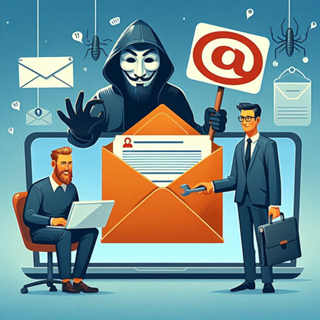What Is Email Spoofing?
(See also About email security)
Email spoofing is a deceptive practice where cybercriminals forge email headers to make it appear as if an email is coming from a legitimate source when, in fact, it is not. This technique is often used to deceive recipients into taking harmful actions, such as clicking on malicious links, downloading malware, or disclosing sensitive information. In this article, we will explore how email spoofing works, what can be done to combat it, and highlight some high-profile cases of victims of email spoofing.

How Email Spoofing Works
Email spoofing involves manipulating the email header information, such as the "From" address, to make it appear that the email originates from a trusted source. This deception is often reinforced by mimicking the legitimate organization's style and branding in the email content. Spoofed emails may contain phishing links or malicious attachments designed to steal information or infect the recipient's computer.
What to Do About Email Spoofing
To protect against email spoofing, consider the following steps:
- Verify the Sender: Carefully check the sender's email address for any inconsistencies or unusual domain names.
- Examine Email Headers: Look at the detailed email headers for signs of spoofing, which many email clients allow you to do.
- Be Cautious with Links and Attachments: Avoid clicking on links or downloading attachments from unverified sources.
- Report Suspicious Emails: Report any suspicious emails to your email provider or IT department to help identify and block spoofing attempts.
- Use Email Filters: Enable spam and phishing filters provided by your email service to catch and block suspicious emails.
Preventing Email Spoofing
While it's challenging to eliminate email spoofing entirely, several measures can significantly reduce its risk:
- Implement SPF, DKIM, and DMARC:
- SPF (Sender Policy Framework): Validates that the sender's IP address is authorized to send emails on behalf of the domain.
- DKIM (DomainKeys Identified Mail): Uses cryptographic authentication to verify that an email message has not been altered during transit.
- DMARC (Domain-based Message Authentication, Reporting & Conformance): Combines SPF and DKIM and provides instructions on how to handle emails that fail these checks.
- Email Authentication and Validation: Regularly review and update your email authentication policies to ensure they are properly configured and enforced.
- Educate Users: Train employees and users about the dangers of email spoofing and phishing. Awareness and vigilance are key in preventing successful attacks.
- Use Anti-Phishing Tools: Deploy anti-phishing software and services that can detect and block spoofed emails before they reach users' inboxes.
- Secure Email Gateways: Use secure email gateways to filter and monitor incoming and outgoing email traffic for signs of spoofing and other malicious activities.
High-Profile Cases of Email Spoofing
Several high-profile cases demonstrate the severe impact of email spoofing:
- Democratic National Committee (DNC) Hack (2016): During the 2016 U.S. presidential election, attackers used spear-phishing emails to compromise DNC officials' email accounts, leading to a significant leak of sensitive information and political fallout.
- Ubiquiti Networks (2015): Ubiquiti Networks lost approximately $46.7 million in a spoofing and phishing attack where attackers impersonated company executives and instructed employees to transfer funds to fraudulent accounts.
- Snapchat (2016): A cybercriminal impersonated Snapchat's CEO in an email to the HR department, requesting employee payroll information. The HR employee, believing the request was legitimate, complied, exposing sensitive employee data.
- FACC (2016): Austrian aerospace parts manufacturer FACC was defrauded of around €50 million through spoofed emails impersonating the CEO and instructing the finance department to transfer funds to fraudulent accounts.
- Scoular Co. (2014): Scoular Co. lost over $17 million in an email spoofing attack where attackers impersonated the company's CEO and convinced the corporate controller to wire funds to a Chinese bank account under the guise of a confidential acquisition.
Conclusion
Email spoofing remains a prevalent threat, but combining technical measures with user education can significantly mitigate its impact. Implementing robust email authentication protocols such as SPF, DKIM, and DMARC, and encouraging cautious email practices are essential steps in defending against spoofed emails. By learning from high-profile cases and adopting comprehensive security measures, organizations can better protect themselves against the potentially devastating consequences of email spoofing.


